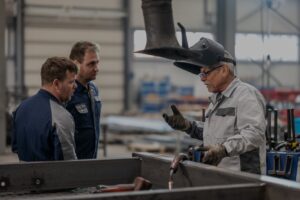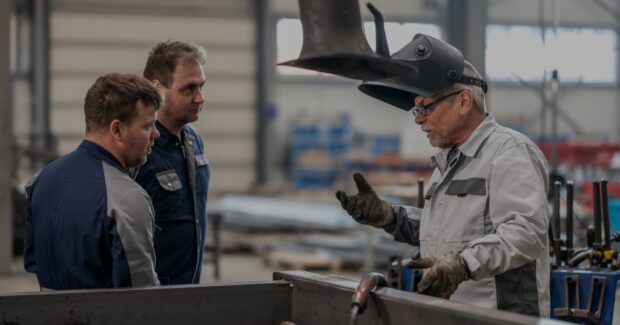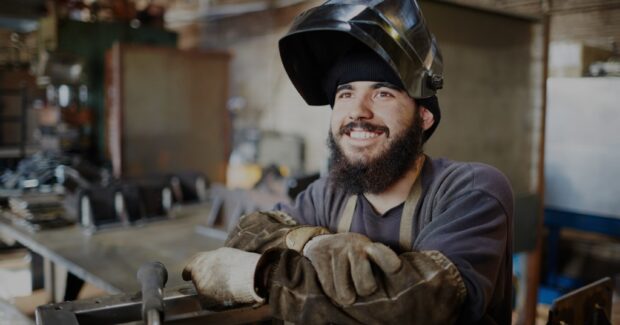Fabrication Safety Programs: Benefits Far Outweigh the Costs
A safety first culture shields your shop from costly fines, productivity setbacks, and potential legal troubles. Safety isn’t just a program; it’s a way to show your employees that you care.
Posted: August 1, 2024

Too many steel fabricators have the wrong idea about safety. They see it as a set of restrictions that limit operations. Or worse: they see it as an expense.
In reality, safety compliance is the ultimate safeguard. It protects against costly fines, productivity setbacks, legal troubles, accidents, and even lost lives. Steel fabrication is a dangerous industry, and not respecting the process is the easiest way to get hurt. So, how do you go about building a safety program?
Step 1: Hazard Identification
The foundation of any effective safety program is a thorough hazard assessment. You walk through the workplace and identify potential sources of harm. During this step, write down everything — no matter how mundane. You’ll circle back to this list later, so write down every potential hazard and take pictures, too. There are the obvious risks, like unguarded machinery or missing handrails. However, you also have to be on the lookout for hidden threats, such as noise exposure. OSHA specifically sets standards related to noise thresholds, monitoring, and PPE usage.
Note: This list isn’t definitive. As time passes you will stumble upon more hazards. Each time you change a workflow process or add new equipment, perform another hazard identification check.
Step 2: Research
With your list in hand, it’s time to hit the books. OSHA.gov literally lists every single law and regulation on the books. Take your list and use their search bar to pull up the related regulations one-by-one. Write down the exact requirements. Fabricators usually have to worry (at the very least) about the following:
| · Hazard Communication
· Control of Hazardous Energy (Lockout/Tagout) · Emergency Action Plan · Personal Protective Equipment · Powered Industrial Trucks · Respiratory Protection · Hearing Conservation · Confined Spaces · Machine Guarding · Fall Protection · Cranes & Hoists |
|
Step 3: Written Program
With all this information in hand, it’s time to compile firm rules in a formal written program. These shouldn’t be generalizations, but as specific as possible to your shop. Saying “always wear PPE” isn’t going to cut it. All your equipment and job tasks should be listed, and steps explicitly listed for each.
For instance, each piece of equipment with multiple energy sources should be listed and each should have its own lockout/tagout procedure. Every step should be listed, including comprehensive training for “authorized” and “affected” employees, removal of energy, verification of isolation, etc.
OSHA’s General Duty Clause
Remember how in step one you wrote down every hazard, no matter how mundane?
We did that because OSHA can fine you for things even if they’re not listed or part of an existing law.
So, if you see that OSHA doesn’t have a guideline for your situation or specific hazard — you’re not off the hook. In fact, it’s the opposite: You’re now solely responsible for creating detailed guidelines for addressing these problems. If it’s a “recognized hazard” in your industry or shop floor, it’s fair game to be cited as a violation.
This applies to heat stress, unsafe product storage, poor ventilation, and even things like violence in the workplace. Just because the law doesn’t specify a standard doesn’t mean you can ignore it.
Step 4: Training
Training will become the cornerstone of your safety program. A written program is a great first step, but unless employees are engaged with the process, nothing actually changes. Key to a successful training process is to select a qualified trainer. The trainer should be
willing to dive deep into the process so they can answer questions that arise and stimulate discussion. The best training programs reflect the real-world scenarios your team may face in their daily tasks. Using examples of past incidents and near-misses help illustrate points and emphasize the importance of following safety protocols.
Each one of the laws listed above in the “Step 2: Research” section has a specific and extensive training requirement. When crafting your training program, double check you’ve explicitly met these points.
Step 5: Routine Inspections
Now that the safety program is in place, your work isn’t over just yet. Inspections are critical for maintaining safety standards. As practices and procedures adapt, new oversights might pop up and existing oversights will be highlighted.
Assign this task to individuals who are skilled in recognizing hazards and are knowledgeable about effective corrective actions. Document each inspection meticulously, including any hazards identified and the corrective measures taken. This documentation is vital for ongoing safety management and for legal compliance.
These inspections need to occur frequently to ensure that hazards are quickly identified and fixed, before they lead to an accident, injury or worse.
Step 6: Enforcing Safety
Let’s get real about enforcement. You put these rules in place for a reason — they protect your team, which should always be your top priority. Too many workplaces have developed a safety program, but it’s not taken seriously. It always ends the same way: somebody gets hurt, and OSHA comes knocking.
How do you go about enforcing these rules? Each time a rule is ignored without consequence, it sends a message that your workers’ safety — and by extension, their lives — don’t really matter. So, how do we fix this?
It starts with creating a clear and escalating discipline process. Think of it as a ‘step-by-step’ system for handling infractions. Small mistakes might get a first warning but repeat offenses or serious breaches should have tougher consequences. Make sure your team knows this isn’t about punishment — it’s about ensuring that everyone understands the importance of safety and feels responsible for maintaining it.
By applying rules consistently, you’re not just enforcing regulations; you’re showing your team that you’ve got their backs. That’s how you build a workplace where everyone feels valued and protected. It’s also how you build a strong “safety culture” at your company.
Building a robust safety program might feel like a never ending task, however it’s this very commitment that will prove to be the most important step of all.
A strong safety culture shields your operation from costly fines, productivity setbacks, and potential legal troubles. More important than all of that: your dedication will protect against injuries and the loss of life. Safety isn’t just a program; it’s the way we show our teams that we care.
Texas Steel Fabrication Safety Consulting






